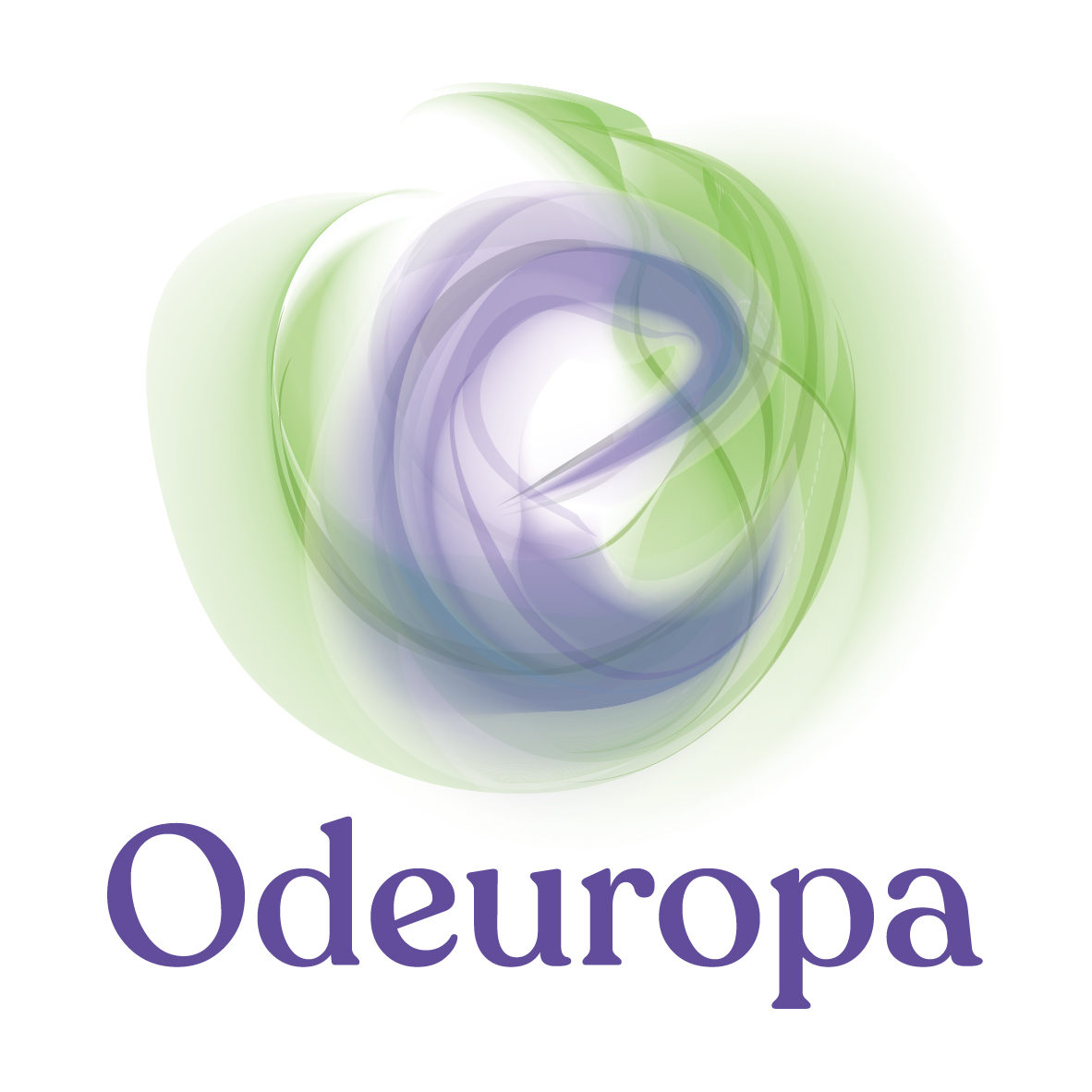This post by Caro Verbeek originally appeared on Futurist Scents
In 2015 I embarked on one of the greatest adventures of my life. IFF (Hilversum), the Rijksmuseum (Amsterdam) and I (Vrije Universiteit Amsterdam) reconstructed a dozen historical and other scents for our joint project ‘In Search of Lost Scents’. All scents were related to art works from the so called ‘Highlight tour’: a unique project combining the best of (very different) worlds.
Right before the lockdown (due to corona) I was able to introduce some of these scents to a group of blind and near sighted people during a tour at the Rijksmuseum, organized by Hannes Wallrafen of Stichting Geluid in Zicht and Cathelijne Denekamp. Denekamp is manager of accessibility in the museum and is convinced the senses can play an important role in inclusivity:
“In order to make objects come to life, touch and smell are essential tools for blind people or people with low vision. The Rijksmuseum is considered a very visual museum. As a museum we acknowledge our responsibility of giving blind people or people with low vision access to art and history without using their eyes. Scent and story-telling enable us to do that.”
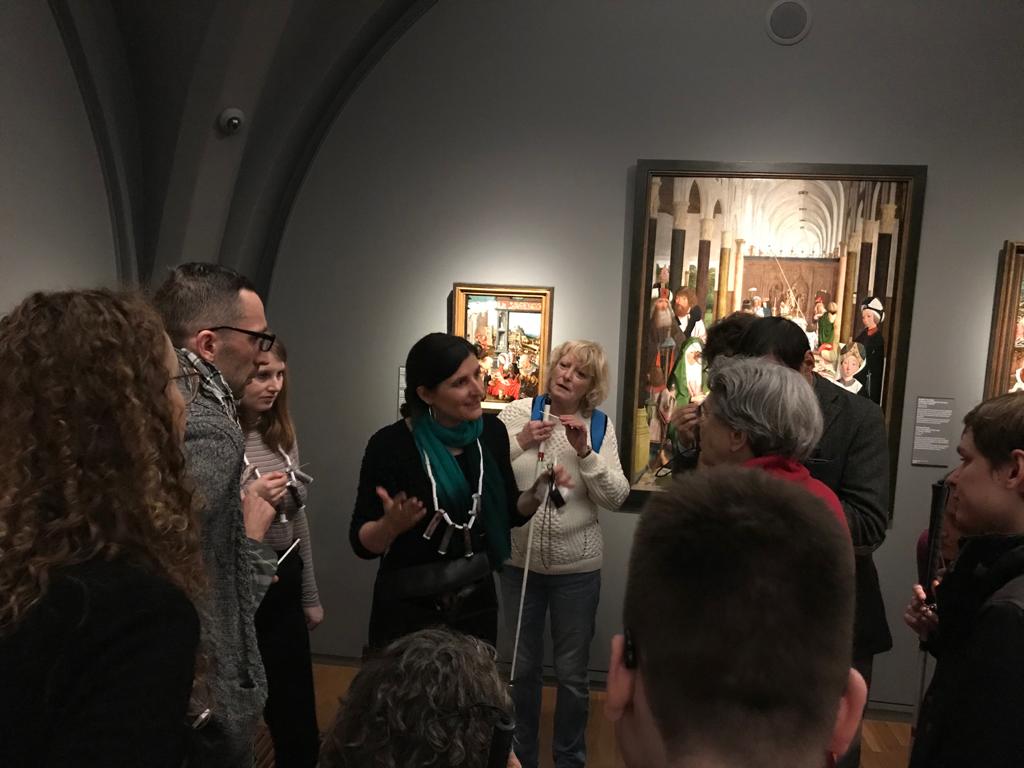
Understanding rituals by the sense of smell – The Adoration of the Magi
We started our multi-sensory tour in the dimly lit vaulted rooms that store medieval and renaissance art works. We halted at the painting ‘Adoration of the Magi’ by Geertgen tot Sint Jans. The artist confronts us with lavishly dressed men holding precious gifts in front of a new-born child sitting on the lap of his mother. After this description the participants recognized the biblical story of the three kings offering frankincense, myrrh and gold to Jesus without even hearing the title of the painting. Not mentioning such details leaves more room for the mind to explore and imagine.
Frankincense and myrrh were meant as burnt offerings to pay honour to kings and gods. In antiquity resins were burnt ‘per fumum’ (through smoke) to make its fragrant emanations reach the nostrils of divine beings. Every contemporary viewer of this painting would have understood that by offering these fragrances these royals symbolically acknowledged the divine and profane superiority of Christ; a meaning that got lost somewhere over the past centuries. And so did the meaning and aromatic quality of one of the scents.
The participants were enabled to actually smell myrrh as part of a story-telling technique. Its aromatic quality (bitter) is connected to its historical meaning: besides being an offering to a god, the bitterness of this resin was considered prophetic and referred to the future suffering of Christ. This means that sensory engagement can actually lead to a better understanding of past rituals. Here’s what participant Emilie De Lanoy Meijer recalled months later:
“Because of the scent of myrrh I instantly felt transported to the story and time it took place.”
Scents are in fact known to elicit intense historical sensations, according to neuro-scientist Richard Stevenson; even more so than images or sounds.
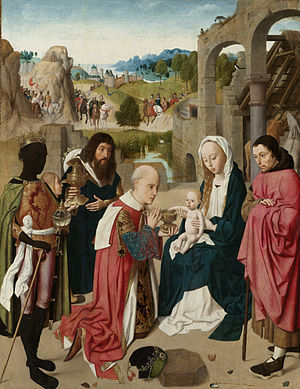
“As a fully blind individual I do not feel any connection to paintings, but rather to stories”
We then took a small detour to a so-called ‘pomander’ in the department of the ‘special collections’. Pomanders are metal jewels filled with fragrances, worn by people of high status such as doctors and lawyers. They were hung from a chain or ‘chatelaine’ so the scents could be taken to the nose at will. Fragrances were supposed to help protect people from diseases, which were thought to be caused by bad smells (think of ‘malaria’ which literally means ‘bad air’). Baring in mind the story surrounding the three magi: a pomander could also function as a prayer nut which contents were an offering or wordless prayer in itself.
Poor people had to make do with strong smelling cheaper products such as vinegar and rosemary to stay healthy, strengthening the already existing olfactory dichotomy poor/ foul – rich/ fragrant that still exists today.
The 17th century pomander in question consists of six compartments, not unlike an orange, or a hand with the palm facing up and the fingers brought together at the top. It can be opened by taking down one of the slices and opening its little drawer. I brought a pomander of about the same size from my own collection and made it pass from hand to hand so people could palpate it. The accompanying scent was a reconstructed recipe from a 16th century book of secrets (recipe book) which is also part of the collection of the Rijksmuseum. It contains nutmeg, clove, cinnamon, rose and (artificial) civet. One participant later recalled this part of the tour very vividly. Anita Gonzalez explained why:
“I clearly remember that silver piece of jewellery. Maybe because we both smelled it and were able to hold one in our hands. More in general the scents really contributed to the stories surrounding the objects, not the artefacts themselves. Being 100% blind I do not feel any connection to – for example – paintings. The scents really made me empathize with people from different eras though. I have an excellent sense of imagination.”
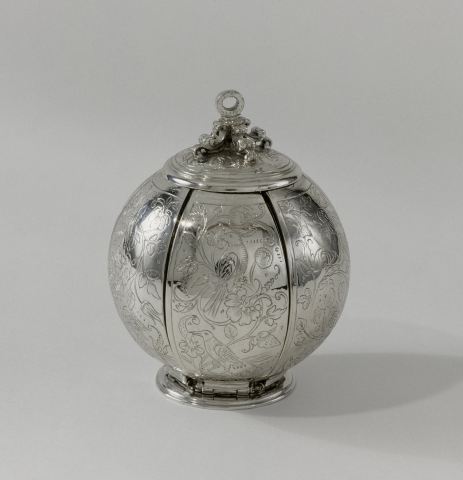
“Art always alludes to its original invisibility, which belongs to the nature of all things, ill-represented by words”
One could argue that museums of visual art are all about objects and their visibilty, but as the quote by Gonzalez illustrates this isn’t the case. Artefacts and paintings refer to and represent concepts, multi-sensory experiences and stories that aren’t just accessible through the eyes, as Bacci and Melcher explain in ‘Art & The Senses (2011):
“The meaning of art can be revealed in many ways. One can carry out a historical, critical, iconological, or iconographic analysis […]. Here we try a different way […]. Here we examine art as a reality that can be seen and sensed […]. In fact, art always alludes to its original invisibility, which belongs to the nature of all things, ill-represented by words.”
That is why giving access to artefacts and stories though different senses really works for people of different abilities.
Explorative hands and curious noses in an 18th century canal house
Our next stop was the 18th century interior of an original canal house, also known as the ‘Beuning Room’. Here we were able to touch (of course with gloves) the fireplace and mirrors adorned with detailed ornaments of leaves and nuts as well as smell the original ambience. I’ve never seen hands as explorative and gentle or noses as curious as the ones beloning to this group of people.
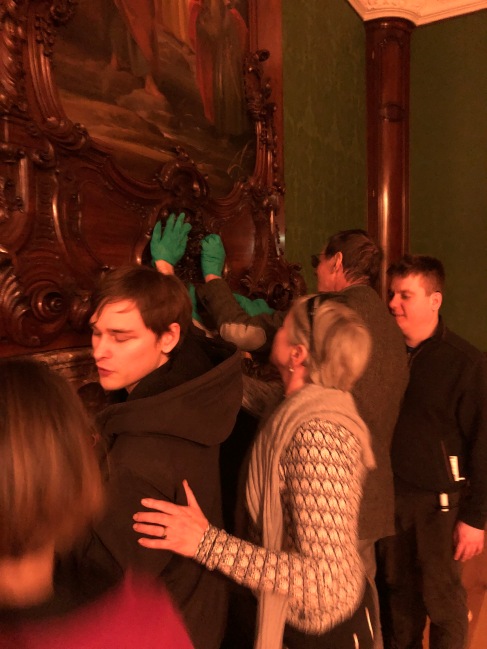
Amsterdam was a very damp place, due to the many canals and lack of double walls. In order to keep moist levels down and fight the smell of mildew and mold (which in Dutch would be described as ‘muf’) burnt fires and people threw resins and spices in the fireplace, rendering the air sweet and pleasant. The outdoor smells of horses, the canal (which was used as a sewer) and the many lime blossom trees, would still penetrate the interior of the house and mingle with the others.
Smelling, touching, listening and also kinaesthesia (sense of space through movement), can really transform a distant object, into an immersive lived experience.
The emanations of the Battle of Waterloo
We then set off to the department of 19th century art and history (we crossed the entire museum) to find out more about the largest painting in the collection “The Battle of Waterloo” by Jan Willem Pieneman (1824). I first walked the full length of the painting so people could hear its vast size by listening to my footsteps. Only then I tried to explain the depicted situation. Several victorious and heroic men on horses are set against a background of thousands of soldiers depicting different stages of the battle. Wellington with his shiny leather boots takes centre stage. The top half of the painting is filled with dark clouds, giving an indication of the harsh weather conditions on that fateful summer day. In the foreground we see wounded soldiers lying on the floor. A lonely canon ball stuck in a muddy puddle tells the story of Napoleon’s defeat: he had hoped his artillery would have led him to victory. But the mud prevented the cannon balls from reaching their desired destinations.
The scent that was especially composed for this painting – created by senior nose Birgit Sijbrands of IFF – reflected many of the visible elements of the story: the weather, damp earth and grass, gunpowder, leather and horses. Even the smell of anxiety, expressed most lively in the eyes of the horses, made its way into the smell. Since human beings are capable of smelling emotions, the smell yields more discomfort than the painting itself.

But one element that was present at Waterloo is not accessible through our eyes at all. Everyday, and also the day of his defeat, Napoleon wore his favorite perfume: acqua mirabilis by Farina. He used it to mask the evil smells of battle but also to stay healthy (remember the pomander). This perfume was used in almost every war since by many soldiers and for the same reasons.
Since this scent is now widely known as 4711 Eau de Cologne, many participants relived episodes from their childhood or suddenly remembered their mothers. That means that a smell can make us feel more closely connected to a historical episode while simultaneously addressing individual experiences. This might be why most participants remembered this part of the tour most clearly:
De Lanoy Meijer recalls:
“Your story was like an explosion of scents before my mind’s nose. When finally you made us smell it, I recognized it even though I hadn’t experienced it before. That made an impact.”
Another participant Hannes Wallrafen (a photographer who had turned blind later in life) commented on the same painting:
“What I remember most clearly of the tour, is the Battle of Waterloo. Its size and complexity were illustrated by your footsteps, story and the scent”.
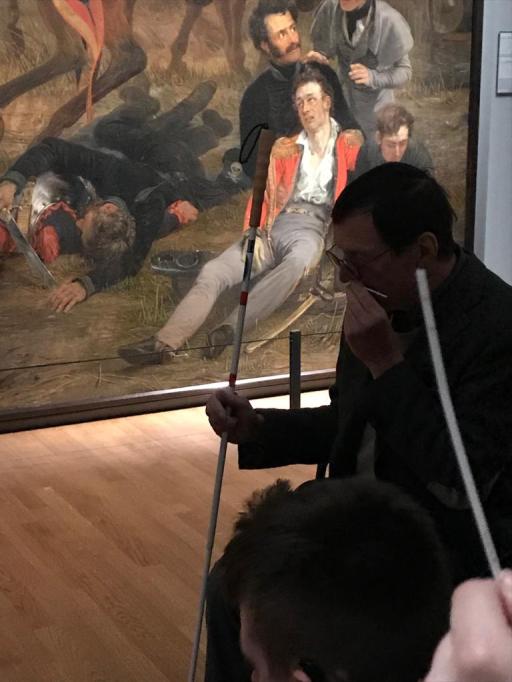
Nostalgia for the nose
We concluded our tour in the ‘attic’ of the museum, touching and smelling the 20th century Bantam airplane. As clinical and pristine as it may look in the museum, it was originally a machine of war that made loud violent noises, that shook heavily, and that spilled motor oil all over the pilot’s face. Since many people still recognize the scent of oil and gasoline, this scent brought up a lot of memories:
De Lanoy Meijer:
“This scent really reminded me of going to the beach as a young girl. I would often step into bits of tar that would stick to my shoes. This is the same scent”.
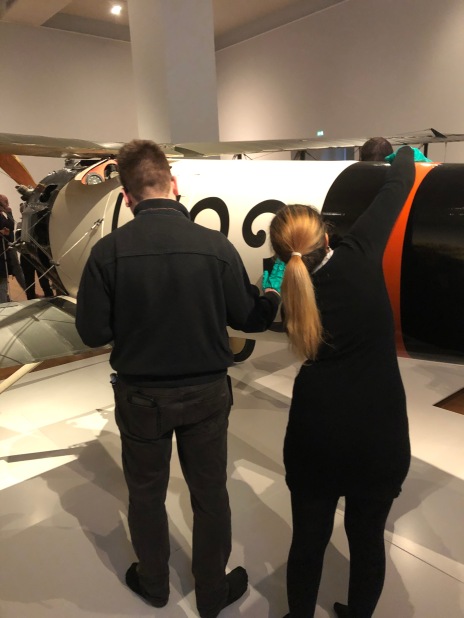

The beauty of a scent tour is that its effects last for months (or even years). Half a year after conducting the tour I spoke to participant Joris Rademakers who is low sighted and also slightly anosmic (smell-blind). The strong smell of oil and gasoline evoked in him a great sense of freedom and pleasure, by just imagining it:
“The scent reminds me of boats and the harbour. My father was always afraid something would happen to me and I felt very restricted in my behaviour. But the moments my uncle took me on his sailing ship, there was this incredible sense of freedom and light-heartedness. I can say that I don’t remember the trip, but actually relive it when I think of this smell. I feel exactly the way I felt back then and the joy this brings lasts all day and makes me forget about other misery.”
Again, a personal story is connected to an artefact by means of the sense of smell, enhancing the memorability of a scent tour.
You see more when you smell
A smell tour for blind and low-sighted people in a museum of visual art has multiple and profound effects:
- smell evokes personal memories as well as historical sensations (a sense of being transported to the past)
- smell is evocative of moods and weather conditions
- smell lifts the boundary between perceived object and perceiving subject
- smell stirs the imagination
- smell makes impressions last longer
- smell adds to the meaning of stories and facilitates the understanding of the original use of artefacts.
Wallrafen summed up the experience of this multi sensory way of telling stories poetically:
“Smelling and listening stimulated my creativity. The multi-sensory way of delivering a story resulted in a very sensual state of mind. I already realized I could ‘see’ through my sense of hearing. But after today I know I can also ‘see’ by my sense of smell”.
As a final take home message I cannot emphasize this enough (and this goes for people of all sensory abilities):
You see more when you smell.
Caro Verbeek is an art and scent historian, specialised in creating smell tours for museums and reconstructing olfactory heritage.
Bernardo Fleming – leader of the olfactive design studio – was the project leader of ‘In Search of Lost Scents’ from within IFF.
Cathelijne Denekamp – head of accessibility within the Rijksmuseum – co-organised this scent tour for blind and low sighted people.
Pauline Kintz – head of adult education – was the project leader of ‘In Search of Lost Scents’ from within the Rijksmuseum.
Inger Leemans – professor of cultural history – was the supervisor of my PhD-project ‘In Search of Lost Scents’ and my PhD-manuscript ‘Smelling Time – the Olfactory Dimension of Futurism’ from within Vrije Universiteit.
